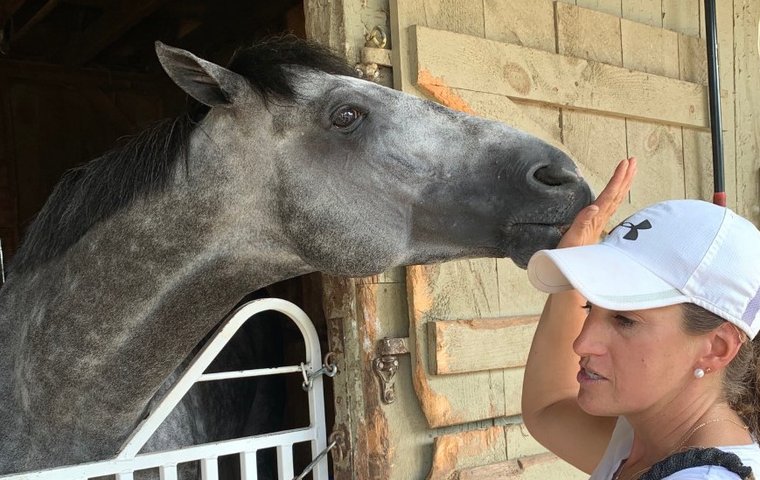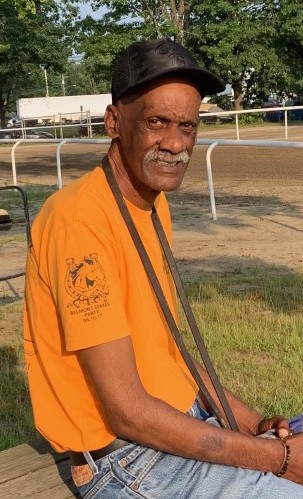
Rick Warner’s first experience of Saratoga came back in 1972. He galloped horses back then. He was born on a horse farm in Virginia. He is 70 now, and his 100-year-old father still lives on that farm. The owner, Mrs T A Randolph, known as the ‘First Lady’ of fox-hunting, promised Warner’s father a home for life and was good for her word.
 “My grandfather worked at that farm also,” said Warner (pictured left). “He was born in 1892. So I was brought up around horses.
“My grandfather worked at that farm also,” said Warner (pictured left). “He was born in 1892. So I was brought up around horses.
“I grew up galloping horses and fox-hunting. When I was 18, I went to work for Frank Wright. Eventually he got me the job on the gate [at Saratoga]. They needed a black guy for diversity laws and I got the job.
“I’ve seen three Triple Crown winners from the gate at Belmont - Affirmed, Seattle Slew and American Pharoah.”
Warner has worked the starting gates for decades now, I knew him from Payson Park, where I wintered a few years back, where he winters every year, still working the gate.
“I’ve had a good career. I remember when I first came to Saratoga we had to pump the water by hand for the horses and us. We had to heat the water. There was no running water.”
He talked of the first time he came to Saratoga. “I worked for Mikey Smithwick. He sent some of us up a week before the horses came so we could set up. We did that in a day and partied for the rest of the week. It was a 24-day meet back then. By the time the meet was over, we’d be relieved to get back to Belmont for a rest.
“I love doing this, teaching the young horses about the starting gate. I still love it. The first time I came here, I thought I could live here.”
And now he does.
A special moment for Brad Cox
Brad Cox hasn’t decided where Knicks Go will head next, but I asked him where it sat winning the Whitney, one of Saratoga’s iconic races, last weekend.
“It’s one of the top I think,” he said. “I mean the Belmont is the biggest one we’ve had, but to be winning on the NYRA circuit, winning the major route dirt race for older horses at the meet. Saratoga is a world stage, the eyes of the world are on it. It was very special. The crowd is electric here.
“I’d never been to Saratoga before I came as a trainer in 2013, not as an assistant or a spectator or anything. I didn’t feel too much pressure when I first came, I was too busy.”
Regarding the race, he said, “Joel [Rosario] suits him well and his best performances are when he gets away and into his rhythm and runs them off their feet. He puts a lot into his works. He’s strong, but overall he’s straightforward to deal with.
“He’s not a big horse, but he’s strong. I think it’s the Awesome Again line - they tend to not be too big - and being by Paynter.”
He was close by, in his stall, Knicks Go. I went to say hello to him. He looked well, bright in his dapple gray coat, on good terms with himself, trying to nip you as colts do. I stroked his nose, patted his neck, told him he cost me a lot of money when he won the Futurity at Keeneland a couple years back.
Then I noticed his jaw. Inter-mandibular width is a thing when assessing racehorses. The width of the jaws correlates to the circumference of the trachea, the windpipe. And, as with all pipes, the greater the circumference the greater the flow rate of whatever is traveling through it.
They say you want to be able to place your fist between the jawbones of a Thoroughbred. You don’t want narrow jawbones in a prospective racehorse. I could nearly have placed two fists between Knick’s Go’s jaw.
Maybe it is a factor, maybe that is why he can run faster and longer, maybe each stride he can take in a bit more fuel than other horses. Horses take a breath each stride in normal conditions, two and a half strides a second. There would have been 270 breaths taken during the course of his race, somewhere around 1,600 gallons of air inhaled.
Just 270 steps 1,600 gallons of air and 108 seconds is all it took Knick’s Go to win the Whitney.
Haven for a true racefan
At the races I spoke to one of Cox’s owners, Staton Flurry, whom I had met briefly at the Fasig-Tipton party. He grew up in Hot Springs, Arkansas. “I used to take the money for parking at the track, and I’d run across to watch the races, and I got to know owners and trainers that way.”
After graduating college, Flurry claimed a horse, and it won its second race. “I was hooked,” he said. “That was 2012, and the next year I hooked up with Brad. Brad is great. He’s very down to earth. He only had ten cheap horses in his barn back then.”
There’s been plenty of progress since those days, including winning the Kentucky Oaks with Shedaresthdevil last year. “It was a blur, the race, the trophy, the press conference,” he said. “And recently we won the Clement Hirsh right here. I got 56 texts after that race. I’ve had over 100 winners now. I run into people I’ve never met before that come up to me and tell me how much they love one of my horses. They are fans of the sport, people who maybe follow me on social media.
“There is so much more access [in horse racing] than in any other sport. You can get involved for $50 with micro shares now.
“I got involved because of the competition, the animals, the people. You are always looking for that next big winner.
“It’s great to be here at Saratoga with all the people back. It’s fan friendly.”
Watching the action from a different angle
I visited the Backstretch Bar for a cold beer. That is worth a visit. it is very different watching the race from the backstretch looking at the stand instead of looking out from under it as the horses flash past.
The sound of hooves striking the dirt, a crack of a whip down the shoulder, a jockey shouts. And, as they turn away and head toward the finish, you hear the noise of the crowd rise to a muted crescendo as they hit the wire.
And then suddenly, the horses are running past you again, pulling up now, blowing hard. The jockeys turn them and they stand up relaxed on the horse now and lope them back to the waiting connections.
Time and again the riders do this. They win some, they lose more, the jockeys of Saratoga. It has ever been thus, from Old Abe Hawkins to Johnny V.


